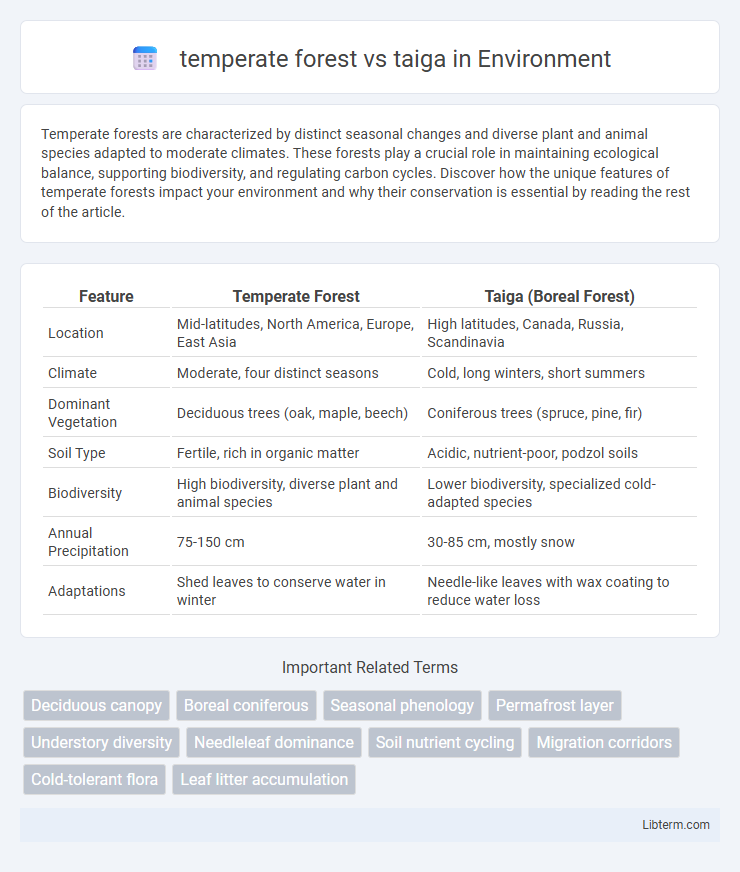Temperate forests are characterized by distinct seasonal changes and diverse plant and animal species adapted to moderate climates. These forests play a crucial role in maintaining ecological balance, supporting biodiversity, and regulating carbon cycles. Discover how the unique features of temperate forests impact your environment and why their conservation is essential by reading the rest of the article.
Table of Comparison
| Feature | Temperate Forest | Taiga (Boreal Forest) |
|---|---|---|
| Location | Mid-latitudes, North America, Europe, East Asia | High latitudes, Canada, Russia, Scandinavia |
| Climate | Moderate, four distinct seasons | Cold, long winters, short summers |
| Dominant Vegetation | Deciduous trees (oak, maple, beech) | Coniferous trees (spruce, pine, fir) |
| Soil Type | Fertile, rich in organic matter | Acidic, nutrient-poor, podzol soils |
| Biodiversity | High biodiversity, diverse plant and animal species | Lower biodiversity, specialized cold-adapted species |
| Annual Precipitation | 75-150 cm | 30-85 cm, mostly snow |
| Adaptations | Shed leaves to conserve water in winter | Needle-like leaves with wax coating to reduce water loss |
Introduction to Temperate Forest and Taiga
Temperate forests are characterized by broadleaf trees and a moderate climate with four distinct seasons, supporting diverse plant and animal species. Taiga, or boreal forest, consists mainly of coniferous trees and endures long, cold winters with short, mild summers, creating habitats for cold-adapted wildlife. Both biomes play crucial roles in carbon storage and biodiversity but differ significantly in vegetation structure and climate.
Geographic Distribution and Climate
Temperate forests are primarily found in eastern North America, Europe, and parts of East Asia, characterized by moderate temperatures and well-defined seasons with ample rainfall ranging from 750 to 1,500 mm annually. Taiga, also known as boreal forest, spans across northern North America, Scandinavia, and Siberia, exhibiting long, harsh winters with temperatures often below -30degC and short, cool summers, with precipitation mostly in the form of snow, averaging 300 to 850 mm per year. The distinct climatic conditions between these biomes influence vegetation density and species adaptation, with temperate forests supporting broadleaf deciduous trees and taiga dominated by cold-tolerant conifers.
Dominant Flora and Vegetation Types
Temperate forests are dominated by broadleaf deciduous trees such as oak, maple, and beech, alongside mixed conifers that contribute to rich, diverse understories with ferns, shrubs, and wildflowers. Taiga, or boreal forests, are primarily composed of coniferous trees like spruce, fir, and pine, adapted to colder climates with needle-like leaves that reduce water loss. Vegetation in temperate forests supports seasonal leaf shedding for nutrient recycling, while taiga vegetation is sparse, with acidic soils limiting the variety of understory plants.
Key Animal Species in Each Biome
Temperate forests host diverse animal species including white-tailed deer, black bears, and various bird species like woodpeckers and owls, adapted to seasonal changes and abundant vegetation. Taiga, also known as boreal forest, supports species such as the moose, Canada lynx, and gray wolf, which are adapted to cold climates and coniferous forest environments. Both biomes feature specialized fauna that play critical roles in their respective ecosystems' food webs and biodiversity maintenance.
Soil Composition and Nutrient Cycling
Temperate forests feature rich, loamy soils with high organic matter content, supporting rapid nutrient cycling through diverse microbial activity and leaf litter decomposition. Taiga soils, known as podzols, are typically acidic, nutrient-poor, and characterized by slow decomposition rates due to cold temperatures, resulting in limited nutrient availability. The contrast in soil composition and nutrient cycling significantly influences vegetation types and ecosystem productivity in both biomes.
Seasonal Changes and Adaptations
Temperate forests experience four distinct seasons with warm summers and cold winters, prompting deciduous trees to shed leaves to conserve water during winter dormancy. Taiga, or boreal forests, endure long, harsh winters and short, mild summers, favoring evergreen conifers with needle-like leaves coated in wax to minimize water loss and withstand snow load. Both biomes exhibit adaptations such as thick bark and antifreeze-like cell sap in plants, enabling survival through extreme temperature fluctuations.
Ecological Roles and Biodiversity
Temperate forests support a highly diverse range of plant and animal species, including broadleaf trees, mammals, and numerous bird species, contributing to complex ecological interactions and nutrient cycling. Taiga forests, dominated by coniferous trees like spruce and fir, provide critical habitats for cold-adapted species such as moose, lynx, and migratory birds, playing a key role in carbon sequestration and climate regulation. Both biomes are essential for maintaining global biodiversity, but temperate forests exhibit greater species richness, while taiga forests cover vast areas influencing large-scale environmental processes.
Human Impact and Conservation Issues
Temperate forests experience significant human impact through logging, agriculture, and urban expansion, leading to habitat fragmentation and biodiversity loss. Taiga regions face threats from large-scale logging, mining, and climate change-induced shifts, affecting carbon storage and wildlife habitats. Conservation efforts in both biomes emphasize sustainable resource management, reforestation, and protection of endangered species to maintain ecosystem resilience.
Economic Significance and Natural Resources
Temperate forests provide valuable hardwood timber such as oak, maple, and beech, supporting extensive furniture, paper, and construction industries, while taiga forests primarily yield softwood like spruce, pine, and fir critical for pulp, paper production, and building materials. Both biomes offer significant non-timber products; temperate forests supply medicinal plants, nuts, and fruits, whereas taiga regions are rich in resin and offer vital habitats for fur-bearing animals integral to local economies. The temperate forest's fertile soils also back agriculture and livestock farming, contrasting with the taiga's limited agriculture but abundant mineral resources like oil, natural gas, and precious metals enhancing its economic importance.
Climate Change Effects on Temperate Forests and Taiga
Climate change accelerates temperature rise in temperate forests, leading to altered species composition, increased pest outbreaks, and heightened wildfire frequency. In taiga, warming temperatures cause permafrost thaw and shifts in tree line northward, disrupting ecosystem balance and carbon storage capacity. Both biomes face challenges in biodiversity loss and altered carbon cycling, intensifying global climate feedback loops.
temperate forest Infographic

 libterm.com
libterm.com